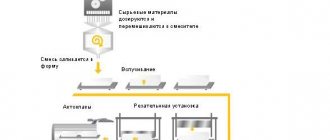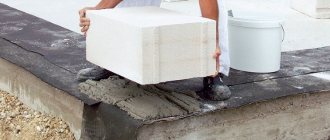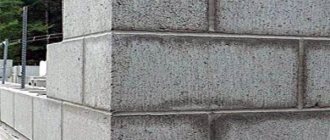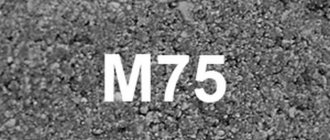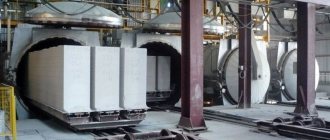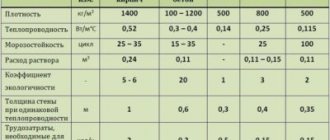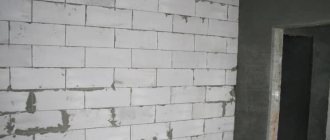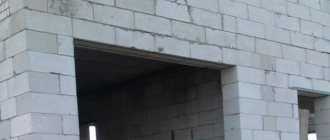Autoclaved aerated concrete N+N is suitable for the full cycle of construction of small houses up to 20 m high. Thanks to its cellular structure, the material retains heat well, is resistant to low temperatures, does not form mold or mildew, and is lightweight. It is produced in blocks of different thicknesses, thanks to which the builder has the opportunity to choose aerated concrete based not only on the size of the building, but also on the climate of the area and the load on the walls.
Advantages and disadvantages of H+H aerated concrete blocks
Like other building materials, H+H aerated concrete blocks have characteristic features, one of which is a porous structure filled with “air cushions”. Thanks to it, the products have undeniable advantages:
- Strength is one of the key indicators of any wall material. Autoclaved aerated concrete has a sufficient class of compressive strength for low-rise construction. From B1.5 TO B7.
- Ease. Due to their cellular structure, the blocks have a low density and light weight. This allows you to reduce the load on the foundation, which significantly saves labor costs on its laying. The low weight also makes it possible to avoid using heavy equipment when laying walls.
- Thermal conductivity and heat capacity. Cellular concrete has the lowest thermal conductivity coefficients, since it does not absorb moisture and has its own “insulation” - air in micropores. For example, in a dry state, aerated concrete D500 has a thermal conductivity coefficient of 0.14 W/(m×°C), while expanded clay concrete with a density of 800 kg/m³ is 0.35 W/(m×°C). At the same time, comparable grades in terms of density are used in the construction of load-bearing walls.
- Frost resistance. Aerated concrete practically does not absorb moisture, which means that frozen water in the pores does not destroy its structure. Therefore, it is used in the northwestern regions of Russia, where operational humidity reaches 6%. Aerated concrete blocks H+H D500 can collapse at a humidity of 40%.
- Vapor permeability is a property of a material that characterizes the ability to pass air vapor through itself, ensuring its circulation. For example, aerated concrete D500 has a vapor permeability coefficient of 0.20 mg/(m×h×Pa), while expanded clay concrete with a density of 800 kg/m³ is 0.08 mg/(m×h×Pa).
- Fire resistance. Aerated block walls do not burn and do not emit toxic substances and suffocating smoke both under the influence of open fire and under the influence of high temperatures.
- Machinability. Gas blocks lend themselves well to any type of mechanical processing. To make an arch in the wall, you do not need to order separately products of a specific shape. You can simply cut it out of blocks yourself.
- Environmental friendliness and safety. Only environmentally friendly materials are used in production. The resulting products are safe for both health and the environment.
In addition to numerous advantages, such cellular concrete also has disadvantages:
- Shrinkage. Any concrete is characterized by such a property as shrinkage. It occurs for several reasons: evaporation of excess moisture during hardening and heavy loads. Subject to the storage and construction rules, shrinkage of aerated concrete walls will occur, but within acceptable limits, which will not affect the quality and durability of the entire building.
- The need for reinforcement. Cellular concrete h+h requires mandatory reinforcement, both for masonry and lintels. The frequency of reinforced rows depends on the project.
- Features of fasteners. Due to the porous structure of such concrete, it is not easy to securely secure any object in it. This requires special fasteners, without which the aerated concrete will simply crumble. Compared to ordinary nails, special fasteners cost an order of magnitude higher. And not all stores can find them.
Expert opinion Vitaly Kudryashov builder, aspiring author
Ask a Question
The advantages and disadvantages of a building material show how good it is. Even if you buy high-quality products, if you violate construction standards, they will not create a durable and reliable structure.
Description of material and composition
H+H aerated concrete blocks are a type of thermal insulation and structural material that is used in the construction of monolithic frame structures and in the reconstruction of real estate. When used, autoclaved aerated concrete allows you to save on insulation and ventilation. Its peculiarity is that it is cellular - created using a mixture of mineral binders - sand, lime, cement and filler. It got its name because all the components of the composition are mixed in a special machine - an autoclave. At the same time, air bubbles form in the material, which gives such concrete positive qualities. Thanks to its components, aerated concrete is lightweight and durable.
Scope of use of H+N gas blocks
H+N aerated concrete blocks are mainly used for building houses. Depending on the strength of the brand, buildings from 1 to 7 floors can be erected from them, including those with a built-in floor, for example, for parking. In addition, such products are suitable for:
- garages;
- baths;
- additional extensions, regardless of what material the main building was made of;
- other enclosing structures, including fences.
Aerated concrete blocks are not suitable for the construction of load-bearing walls of commercial or industrial premises. But, during the construction of such objects, they are widely used for the protection of metal structures, installation of ventilation and elevator shafts. The construction of partition walls is allowed.
Advantages: what are they expressed in?
Thanks to the various ingredients in its composition, foam concrete is considered an environmentally friendly material, it does not contain harmful substances, and also has the following advantages:
This material has a whole list of advantages.
- high vapor permeability;
- reducing indoor humidity;
- improved ventilation;
- frost resistance;
- thermal insulation;
- durability;
- ease;
- high fire resistance;
- soundproofing;
- heat capacity.
Characteristics of aerated concrete N+N
The physical and mechanical characteristics of aerated concrete depend on its density.
| Brand | D300 | D400 | D500 | D600 |
| Standardized bulk density, kg/m3 | 300 | 400 | 500 | 600 |
| Compressive strength class | B 2.0 | B 2.5 | B 3.5 | B5.0 |
| Dry thermal conductivity coefficient λ0 [W/(m×C)] | 0,075 | 0,096 | 0,12 | 0,14 |
| Thermal conductivity coefficient at humidity 5% λB [W/(m×C)] | 0,92 | 0,117 | 0,147 | 0,183 |
| Drying shrinkage, [mm/m], no more | 0,3 | |||
| Frost resistance grade | F100 | |||
| `Fire resistance limit | not less than REI 240 | |||
Deviation from the specified geometric dimensions in length and thickness is no more than ±1.5, in height no more than ±1.
Advantages
The main advantages of gas blocks include:
- Ease of transportation and storage.
concrete compressive strength; - fire resistance;
- soundproofing;
- light weight of building materials;
- cost-effectiveness (when building walls, you can reduce the cost of laying the foundation and the cost of construction glue);
- speed of work (special grips reduce the cost of physical labor for builders);
- no need for additional leveling of the walls before final finishing work;
- ease of storage and transportation (H+H aerated concrete is packaged in a dense polyethylene film, which protects it from debris and moisture).
Return to contents
Types of blocks
Aerated concrete N+N is produced in several series. They differ not only in physical and mechanical characteristics, but also in geometric parameters. The production technology and materials used for all H+H products are identical.
H+H Block Extra
H+H Block Extra is produced:
- With a tongue-and-groove system, which ensures denser masonry and minimizes installation adhesive. As a rule, such blocks are used for the construction of partitions.
- With a special mounting grip that facilitates the laying process.
H+H Block Extra – structural and thermal insulation products. Available in densities D400, D500, D600.
H+H Block
H+H Block is a series of standard blocks, without any additional elements. Variations of sizes are different. The most common are 600*400*200 mm. Suitable for the construction of load-bearing walls. Less commonly produced with a tongue-and-groove system. The H+H Block series produces products with density grades D500, D600. This is enough to build a three-story house.
Characteristics
- Thermal protection properties. Compared to other modern materials for wall construction, aerated concrete blocks have the lowest thermal conductivity. Concrete grades D500, D600 are heat-insulating building materials, the thermal conductivity of which allows you to save heat indoors in winter. Buildings made of aerated concrete blocks do not overheat even in the hot season. The thermal insulation characteristics of gas blocks help save money on heating buildings by about 30 percent.
- Vapor permeability. In buildings made of aerated concrete, an optimal temperature regime is established: there is no dryness or high humidity in the rooms. The microclimate in buildings is formed due to the vapor permeability of concrete.
Advantages of H+H aerated concrete. - Moisture resistance. The moisture content of the building material is about eight percent.
- Fire resistance. Aerated concrete blocks are non-flammable building materials with increased fire resistance. In addition, aerated concrete does not allow fire to spread.
- Soundproofing properties. The sound insulation of aerated concrete walls will depend on the thickness, as well as the brand of concrete used and the technology of wall laying.
- Durability. The service life of the building material has been proven in practice. Thus, aerated concrete houses built in Scandinavia have been in good condition for seventy-five years. However, cracks have not yet begun to appear on the buildings. The durability of the walls with proper installation work is at least one hundred years.
- Economic indicators. Aerated concrete blocks allow for quick construction work. And since the dimensions of aerated blocks are larger than those of bricks, it is much easier for builders to lay walls. Due to the low weight of the products, it is possible to reduce the cost of transporting aerated concrete to the site and masonry. Aerated blocks can be laid faster than brick. To lay a brick, builders will need about twenty operations, and the mass of such masonry is greater than the mass of aerated concrete blocks. In addition, walls made of aerated blocks will not require additional finishing work, in particular, leveling the surface of the walls.
- Ease of transportation. Weight and dense packaging make it easy to transport aerated concrete.
- Strength. Aerated concrete blocks are made using special autoclaves. Subject to technology and proportions, specialists manage to create cellular concrete. Due to the components that make up aerated blocks, a unique structure of the material is obtained, giving it high strength and other characteristics.
What tools are needed for aerated concrete N+N
Although aerated concrete is easy to lay and process, working with it requires a certain set of tools:
- Block grips. Tools for h+h aerated concrete, which does not have special mounting recesses. Makes it easier to carry products without damaging them. The width and length of such tools are adjustable.
- Hand saw. It looks like a saw for woodworking. Only aerated concrete is thicker, larger, and has additional soldering on the teeth.
- Pleaser. Indispensable for cutting straight angles.
- Carriage. It is used for uniform application of masonry mortar on horizontal surfaces of aerated blocks.
- Trowel. Required for applying a solution of 1-3 mm. You can work with both horizontal and vertical surfaces. For each block width there must be a trowel of the appropriate size.
- Sanding board. Designed to remove small irregularities on the surface of the block. Without them, the installation seam will be smoother and less thick.
- Wall chaser. Aerated blocks are easy to process. Using a wall chaser, you can make grooves of the same depth in them for laying communications.
Expert opinion Vitaly Kudryashov builder, aspiring author
Ask a Question
It is possible to work without such tools. But, they greatly facilitate the work and minimize damage to products.
